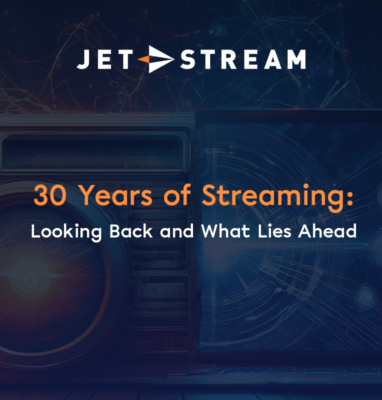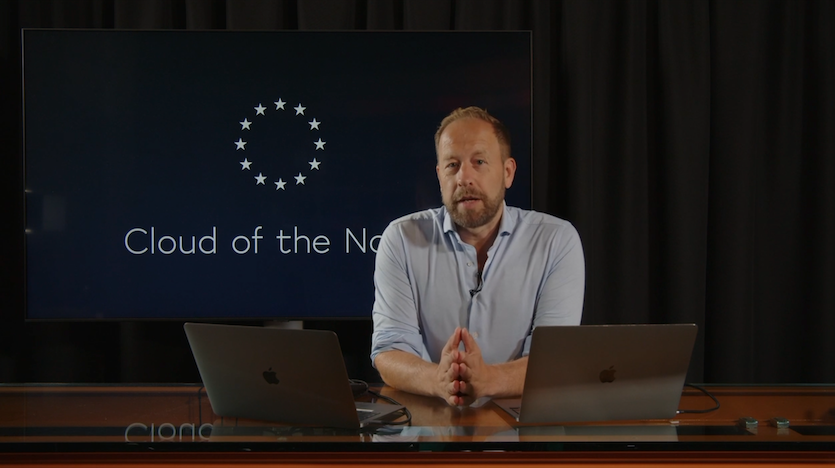Thirty Years of Streaming: Looking Back and What Lies Ahead
Last updated: 11 September 2024

2024 marks a significant milestone: 30 years since the first livestream. Stef van der Ziel, founder of Jet-Stream and one of the early inventors of streaming, has been part of this journey from the start.
In this article, Stef takes us back to the early days of livestreaming, sharing the story of how Jet-Stream played a key role in the evolution of the technology. He also talks about the future of streaming and how Jet-Stream continues to lead the way with new innovations and solutions.
For those who prefer to listen, you can enjoy a detailed discussion of these topics in our accompanying podcast episode.
The Nineties: A New Generation
In the early 1990s, it’s hard to imagine now, but back then, MTV and a handful of radio stations were your only sources of music through the media. The rest had to be discovered through music magazines, live concerts, or by browsing your local CD store (vinyl records were out of fashion).
The TV world was captivated by DVB: digital television via satellite and cable. For them, this was groundbreaking, but for us, it was the old world in a new package. The real new world was ours: we were the new generation, the internet generation, pioneers. The web allowed us to make our voices heard. Everyone could do it. The democratization of media.
No longer did a few radio and TV stations or newspapers dictate what we saw, read, or heard. Companies and politicians no longer decided which information and culture we received. The internet brought about a massive revolution, not just technically, but also socially and culturally.
We worked in the underground music scene, encountering the widest array of new music of our time daily: grunge, hip-hop, and dance, for example. And what did MTV offer? Bland, mainstream content. The internet’s potential was that anyone could start their own music channel. Everyone could decide what (and when!) they wanted to watch.
Pioneering the Streaming Revolution
We were eager for this revolution. You don’t wait for it; you create it yourself. Not by protesting, but by doing. One night at the bar (the best ideas are born at the bar 😉 we decided to start filming live concerts and offering them ‘on-demand’ via the Internet. And we decided to start broadcasting concerts ourselves. Forget MTV. Haha.
In 1993, we started uploading concert clips to the web. And in 1994, something magical happened: a real livestream of video images on the web. The very first one, as far as we could tell. (Here’s a fun documentary about that time).
Granted, it was only a tiny window, with just one frame per second, but the first moon landing also began with a very simple computer and one small step.
For us, this was our moon landing. One that would radically change the world. Because within ten years (we predicted) internet video would have crushed the old media.
Admittedly, it took longer. Our mission became: improving the internet so that everyone can broadcast live, and everyone can watch what they want.
2024: Mission Accomplished?
The generation that still watches TV is literally dying out. Online video is everywhere. Whether it’s on-demand entertainment (the buzzword is OTT), live channels (nowadays that also needs a buzzword: FAST), video calls, or business communication. Even more and more business processes rely on digital video and audio.
Thanks to AI (another buzzword), we see a huge shift from text to audio and video. It makes sense because through audio and video you can share much richer information and context so much faster—seeing and hearing is how our brains work.
However, this revolution also has its downside, as it turns out. We live in a world where every global citizen can have and express an opinion, no matter how funny, nonsensical, stupid, or harmful it may be.
Instead of bringing people closer together, the web sometimes drives them apart, with thousands of Opinions on Freedom of Speech, polarization through algorithms, and cultural skirmishes. So be careful what you wish for 😉
Pride
Personally, I’m incredibly proud that we’ve been able to contribute to such a beautiful revolution, and that Jet-Stream has been a stable and innovative partner for our customers for 21 years, continuing to pioneer. It’s also great that former colleagues have continued in the streaming market. Streaming is an industry that never lets you go.
Pioneering
Streaming is essentially fully developed. It has become mainstream, just like television did back in the day. Innovations no longer lie in the core issues of the past: scalability, quality, performance, monetization—all of that has been pretty much sorted out.
The innovations are now in ‘softer’ areas like green streaming (it consumes a lot of energy), and data protection (who is watching what you’re watching?). We at Jet-Stream are proud to have been streaming green since 2004. This year, we won the Privacy Award for our investments in a true European Sovereign Cloud for video and streaming. We’ve put these developments on the agenda in our industry.
Or the innovation lies in improvements like security, resilience, efficiency, and cost savings:
Security
If you knew how many streaming portals, set-top boxes, and streams could be hacked and taken over, it’s a wonder the number of incidents isn’t higher. The focus is often on DRM protection of content, but many systems are as leaky as a sieve, with all the associated risks: channel hijacks, theft of customer data, misuse of viewer data, platform shutdowns and ransoms, content and mass audience manipulation, and other nasty things. There’s hardly any focus on this, and that’s worrying. Expect Jet-Stream to lead the charge in bringing more attention to this issue, in addition to privacy, and to put it on the industry’s agenda.
Efficiency: Workflows
In the professional streaming market, specialists or integrators often work by installing, configuring, and linking a mix of vendor products in the cloud, with custom solutions. These are expensive undertakings. Not only do they consume a lot of hours upfront, but maintaining such a workflow is also costly. Not to mention making any adjustments to your workflow.
Add to that the cloud costs, and the business case for your streaming service is shaky. Great for the specialists and integrators, not so great for you.
To make this much more efficient, we developed a smarter cloud, where all those components are already installed and integrated. The open setup allows you to adjust and even replace any component. This saves significantly on one-time and operational structural costs. We’re talking about hundreds of thousands in one-time and annual structural savings.
New Workflow Tools
I’d like to highlight a few new exciting workflow tools that are part of the Jet-Stream Advanced Media Streaming Suite (AMSS), a comprehensive platform designed to optimize and simplify streaming operations. AMSS provides a powerful set of features, including our latest innovations such as dynamic packaging, media matrix, and asset intelligence.
For a more detailed overview of the capabilities and benefits of the AMSS, you can watch the video below.
1) Dynamic Packaging
Through collaboration with Unified Streaming and thanks to deep integration, you can now use dynamic packaging via Jet-Stream without having to install, configure, manage, and integrate Unified Streaming on multiple cloud instances yourself. Simply upload your MP4, and determine via the URL, API, or configuration per viewer how the stream should be packaged. With or without DRM, HLS or DASH, which bit rates, which languages, which subtitles, H.264 or H.265, with or without HDR, with or without surround sound, and so on. The service is automatically redundant across multiple cloud zones and automatically scales containers up and down based on your load. A system integrator would spend weeks on this; with Jet-Stream, it’s built-in.
2) Media Matrix
Creating a workflow from an encoder, a transcoder, a packager, and a CDN is relatively simple. A somewhat skilled specialist can link these components together. But it’s a static environment that isn’t future-proof in many use cases. And try making such a setup dynamically redundant.
Jet-Stream Cloud isn’t a generic cloud; it’s a cloud specifically developed for video and streaming. An integral part of this cloud is the Media Matrix, which creates an extra abstraction layer between the ingest and the output.
The Media Matrix ensures that content is automatically routed internally, for example, between multiple zones. So even if you deliver a livestream to just one zone (instead of redundantly), the Matrix knows how to find that source in the other zone(s), ensuring the stream is redundantly present within the platform.
The Media Matrix can also be used to switch between sources. For instance, you can switch from live to VOD and vice versa. The Media Matrix is content-aware and knows whether a livestream is also available in a transcoded version within the cloud and in which languages, bit rates, and other variants.
The Media Matrix in Jet-Stream Cloud saves your specialist or integrator a lot of time, and therefore money, in setting up your workflow and offers more future-proofing.
3) Asset Intelligence
The world used to be relatively simple: you had a streaming file (or livestream) in an origin or CDN, and alongside that, some metadata in a CMS or VMS, like the title, description, and author.
Today, a video is no longer just one file; it’s a rich collection of video bit rates, languages, audio tracks, subtitles, DRM configurations, packaging instructions, poster images, and thumbnails, for example.
You could dump all these files into an origin bucket and serve them via a CDN, but managing that grab bag of hundreds of thousands of files becomes a nightmare. You don’t want to leave this management to a CMS or VMS either.
For this reason, asset intelligence is built into Jet-Stream Cloud. Customers can upload the files themselves or have Jet-Stream Cloud generate them. In both cases, all files are analyzed, creating a rich dataset about the ‘asset’: color spaces, bit rates, audio tracks, and so on.
Based on the customer’s configuration or API instruction, all media is rendered (transcoding) and neatly stored in one virtual asset. This way, you can manage each title in an organized manner.
Based on this, you can create unique renditions for each asset. You can make these dynamic or static. A rendition is a served variant of your entire asset. A rendition might include a limited set of languages, bit rates, or colour spaces, or audio.
Such technology won’t be found in generic clouds. Specialists and integrators often skip these steps because it’s too complex, or they charge you heavily for developing custom tools.
Partnerships
To better assist customers, Jet-Stream has entered into new partnerships:
1. Akamai and Jet-Stream
Thanks to our partnership with Akamai for Multi-Cloud, your streaming workflow can be distributed across multiple clouds for global scalability, geography, and redundancy. Whether it’s built-in transcoding, packaging, origin or that of Unified Streaming or Bitmovin, everything runs automatically and is integrated across multiple clouds and multiple zones for extreme scale and uptime. Thanks to all the built-in media workflow orchestration and automation tools, Akamai cloud customers enjoy all the time and cost benefits compared to generic clouds.
2. Audienceplayer and Jet-Stream
Your choice: build your own Netflix with a system integrator and pay hundreds of thousands or millions to go live in a year, or work with Jet-Stream and Audienceplayer and launch your own OTT platform within a week for a small monthly fee. Including VMS, portal, DRM, payment systems, marketing automation, smartphone apps, and smart TV apps, multiple CDNs, live streaming, FAST, and advertising options.
3. Netint and Jet-Stream
Jet-Stream Cloud and MaelStrom On-Prem offer two powerful live and VOD transcoding solutions. Thanks to integration with Netint, Jet-Stream pioneered hardware-accelerated transcoding in the cloud: saving 90% in power consumption. MaelStrom On-Prem takes it further: with one 1U server, you can transcode 300 live channels with less than 500w of power. And thanks to the built-in cloud technology, you can easily create your own transcoding cloud, with automatic scaling and load balancing. The convenient interface allows you to easily add, transcode, and serve live channels. The technology will also be available in Akamai Cloud.
Thirty years of streaming, and pioneering remains in our blood. See you at IBC!




